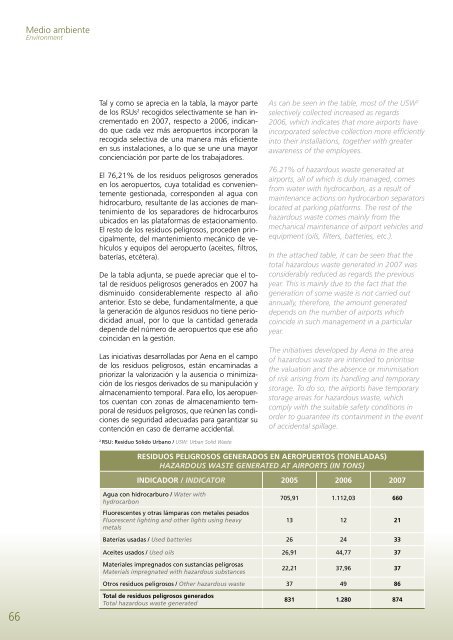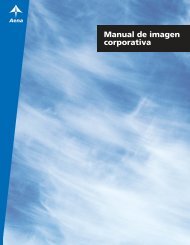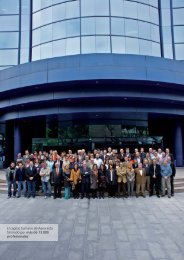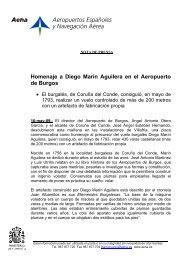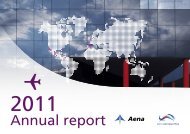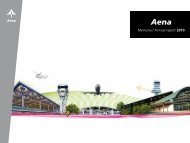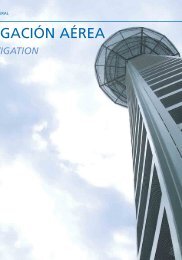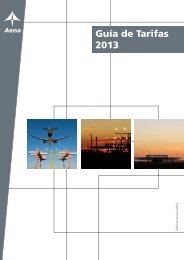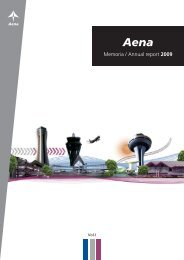Medio ambiente PDF (566 KB.) - Aena.es
Medio ambiente PDF (566 KB.) - Aena.es
Medio ambiente PDF (566 KB.) - Aena.es
You also want an ePaper? Increase the reach of your titles
YUMPU automatically turns print PDFs into web optimized ePapers that Google loves.
66<br />
<strong>Medio</strong> <strong>ambiente</strong><br />
Environment<br />
Tal y como se aprecia en la tabla, la mayor parte<br />
de los RSUs 2 recogidos selectivamente se han incrementado<br />
en 2007, r<strong>es</strong>pecto a 2006, indicando<br />
que cada vez más aeropuertos incorporan la<br />
recogida selectiva de una manera más eficiente<br />
en sus instalacion<strong>es</strong>, a lo que se une una mayor<br />
concienciación por parte de los trabajador<strong>es</strong>.<br />
El 76,21% de los r<strong>es</strong>iduos peligrosos generados<br />
en los aeropuertos, cuya totalidad <strong>es</strong> convenientemente<br />
g<strong>es</strong>tionada, corr<strong>es</strong>ponden al agua con<br />
hidrocarburo, r<strong>es</strong>ultante de las accion<strong>es</strong> de mantenimiento<br />
de los separador<strong>es</strong> de hidrocarburos<br />
ubicados en las plataformas de <strong>es</strong>tacionamiento.<br />
El r<strong>es</strong>to de los r<strong>es</strong>iduos peligrosos, proceden principalmente,<br />
del mantenimiento mecánico de vehículos<br />
y equipos del aeropuerto (aceit<strong>es</strong>, filtros,<br />
baterías, etcétera).<br />
De la tabla adjunta, se puede apreciar que el total<br />
de r<strong>es</strong>iduos peligrosos generados en 2007 ha<br />
disminuido considerablemente r<strong>es</strong>pecto al año<br />
anterior. Esto se debe, fundamentalmente, a que<br />
la generación de algunos r<strong>es</strong>iduos no tiene periodicidad<br />
anual, por lo que la cantidad generada<br />
depende del número de aeropuertos que <strong>es</strong>e año<br />
coincidan en la g<strong>es</strong>tión.<br />
Las iniciativas d<strong>es</strong>arrolladas por <strong>Aena</strong> en el campo<br />
de los r<strong>es</strong>iduos peligrosos, <strong>es</strong>tán encaminadas a<br />
priorizar la valorización y la ausencia o minimización<br />
de los ri<strong>es</strong>gos derivados de su manipulación y<br />
almacenamiento temporal. Para ello, los aeropuertos<br />
cuentan con zonas de almacenamiento temporal<br />
de r<strong>es</strong>iduos peligrosos, que reúnen las condicion<strong>es</strong><br />
de seguridad adecuadas para garantizar su<br />
contención en caso de derrame accidental.<br />
2 RSU: R<strong>es</strong>iduo Sólido Urbano / USW: Urban Solid Waste<br />
As can be seen in the table, most of the USW 2<br />
selectively collected increased as regards<br />
2006, which indicat<strong>es</strong> that more airports have<br />
incorporated selective collection more efficiently<br />
into their installations, together with greater<br />
awaren<strong>es</strong>s of the employe<strong>es</strong>.<br />
76.21% of hazardous waste generated at<br />
airports, all of which is duly managed, com<strong>es</strong><br />
from water with hydrocarbon, as a r<strong>es</strong>ult of<br />
maintenance actions on hydrocarbon separators<br />
located at parking platforms. The r<strong>es</strong>t of the<br />
hazardous waste com<strong>es</strong> mainly from the<br />
mechanical maintenance of airport vehicl<strong>es</strong> and<br />
equipment (oils, filters, batteri<strong>es</strong>, etc.).<br />
In the attached table, it can be seen that the<br />
total hazardous waste generated in 2007 was<br />
considerably reduced as regards the previous<br />
year. This is mainly due to the fact that the<br />
generation of some waste is not carried out<br />
annually, therefore, the amount generated<br />
depends on the number of airports which<br />
coincide in such management in a particular<br />
year.<br />
The initiativ<strong>es</strong> developed by <strong>Aena</strong> in the area<br />
of hazardous waste are intended to prioritise<br />
the valuation and the absence or minimisation<br />
of risk arising from its handling and temporary<br />
storage. To do so, the airports have temporary<br />
storage areas for hazardous waste, which<br />
comply with the suitable safety conditions in<br />
order to guarantee its containment in the event<br />
of accidental spillage.<br />
r<strong>es</strong>iduos PeliGrosos Generados en aeroPuertos (toneladas)<br />
HAzArDOuS WASTE gENErATED AT AIrPOrTS (IN TONS)<br />
indicador / INDICATOr 2005 2006 2007<br />
Agua con hidrocarburo / Water with<br />
hydrocarbon<br />
Fluor<strong>es</strong>cent<strong>es</strong> y otras lámparas con metal<strong>es</strong> p<strong>es</strong>ados<br />
Fluor<strong>es</strong>cent lighting and other lights using heavy<br />
metals<br />
705,91 1.112,03 660<br />
13 12 21<br />
Baterías usadas / Used batteri<strong>es</strong> 26 24 33<br />
Aceit<strong>es</strong> usados / Used oils 26,91 44,77 37<br />
Material<strong>es</strong> impregnados con sustancias peligrosas<br />
Materials impregnated with hazardous substanc<strong>es</strong><br />
22,21 37,96 37<br />
Otros r<strong>es</strong>iduos peligrosos / Other hazardous waste 37 49 86<br />
total de r<strong>es</strong>iduos peligrosos generados<br />
Total hazardous waste generated<br />
831 1.280 874


